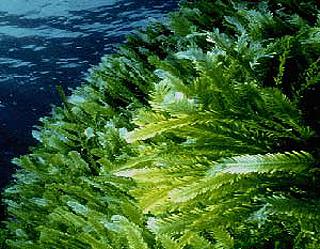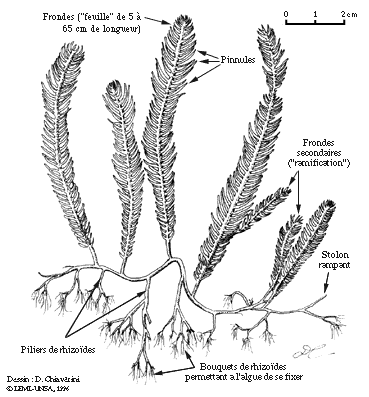Research Technical Report
Monterey Bay National Marine Sanctuary Fact Sheet: Caulerpa taxifolia
 Description:
Description:
Green algae with feather-like branches, leaf is 5-65 cm in length, tropical in origin, found in Caribbean Sea and Indian Ocean, hybrid form found in Mediterranean Sea is much larger (plants up to 10 ft.), and can survive out of water for up to 10 days. It can survive in a wide variety of habitats, including sandy bottoms, rocky outcroppings, mud, and natural meadows. It can cover up to 100% of the sea bottom from 1 to 35 m and has been observed in patches up to 100m, although, at greater depths the patches are less dense. While this is a tropical species, the hybrid prefers cooler water, 10°C, but has been found thriving in temperatures of 5°C. It has been found in headlands and sheltered bays and the growth rate appears the same in polluted harbors and areas away from pollution.
The plant contains a toxin that is not harmful to humans. Most fish and invertebrates avoid it and some studies have shown it to be lethal to certain species. There are also studies suggesting that the toxin may interfere with the eggs of some marine organisms, and kill off many microscopic organisms. The plant blankets an area, pushing out the invertebrates, fish, and native algae.
History:
This plant is often used in saltwater aquariums, home and public, because it is hearty, and has a bright green color that compliments the colorings of tropical fish. It was used at the Stuttgart Aquarium in Germany and a heartier hybrid was unknowingly produced and then shared with several other marine institutions. It is believed to have been leaked into the environment from the Oceanographic Museum in Monaco (although they deny this) and has spread at a quick pace.
In the Mediterranean, what started as 1 meter2 has spread to over 2.5 acres in less than 5 years. It now covers more than 10,000 acres. Dissemination takes place primarily by fragmentation.
This plant was only recently banned from sale in the U.S. It is still available over the Internet and can easily be confused with the less toxic species Caulerpa sertularioides.
Methods of Control:
Many methods to control this plant have been tested throughout the Mediterranean. Some have tried to tear up the patches of algae but one torn leaf that gets away can generate a whole new outbreak. Divers have used pumps to pull out the plant but it seems to regenerate in the same place at a rate quicker than its original growth rate. Other eradication methods include poison, smothering the algae with a cover that lets in no light, and using underwater welding devices to boil the plant. Two species of marine snail, Aplysia depilans and Elysia subornata, that attack the algae have been found. The Aplysia depilans snail contains a toxin itself and is avoided by other marine life. Neither has been tested in open water since its overall affect on the ecosystem has not been determined.
Recent Outbreak:
The recent outbreak covering 0.5 acre in a lagoon just north of San Diego was discovered in late June, 2000 by divers performing habitat monitoring surveys for a nearby power plant. The most probable cause of this outbreak is that a home aquarium was emptied into either the lagoon or a storm drain. The area has been roped off and is under 24-hour watch. Plans are underway to tarp over the area and poison the plant underneath with chlorine.
Morphology of Caulerpa taxifolia

Contact for information about recent outbreak: Bob Hoffman, National Marine Fisheries Service for Southern California. Phone: (562) 980-4043 E-mail: bob.hoffman@noaa.gov
Cite as: Makowka, J. 2000. Monterey Bay National Marine Sanctuary Fact Sheet: Caulerpa taxifolia. Report to the Monterey Bay National Marine Sanctuary.
